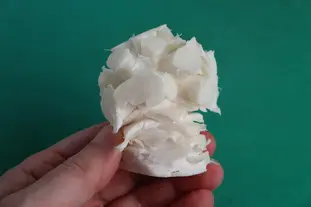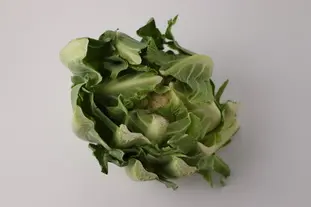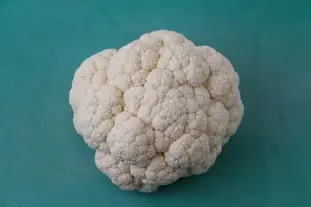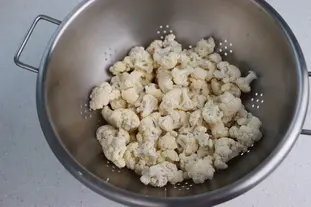This site uses only a few technical cookies necessary for its operation. By continuing to browse, you accept their use.
To find out more...
To find out more...
The "pith" of the cauliflower

When using cauliflower in a recipe, there is a lot of preparation work at the beginning: removing the leaves, taking the tops or florets, etc.
It's a bit tedious, but in the end you're left with the best of the cauliflower, ready to be used in your recipe.
It's a bit tedious, but in the end you're left with the best of the cauliflower, ready to be used in your recipe.
14 K 4.9/5 (14 reviews)
Keywords for this post:CauliflowerVegetablesBroccoliRecoveryTrimmingsLeftoversUseLast modified on: February 5th 2022
The "pith" of the cauliflower
We usually go through these 3 steps:
And it is only afterwards that the recipe really begins, the tops go into the cooking process for example.
But once we're done, the work surface is covered with cauliflower leaves and trimmings, and in particular with this:
Which is the center rib of the cauliflower, on which all the heads you patiently cut and removed were hanging.
This big white thing, which french chefs curiously call "the pith", we would be tempted to throw it in the compost with the rest of the trimmings, but that would be a shame.
In fact, it can be eaten, like the tops, you just have to cut it into pieces and then treat it like the rest of the cauliflower.
You will notice that, depending on the freshness of the cauliflower, it is slightly harder than the rest, but don't worry: start cooking with only the pith for 1 minute, and then continue by adding the rest, in the usual way.
Note that this process can be applied to other cabbages: broccoli, romanesco among others.
To sum up: Do not throw away the center of cauliflower, broccoli or romanesco cabbage, this part can be cooked with the rest of the vegetable.



And it is only afterwards that the recipe really begins, the tops go into the cooking process for example.
But once we're done, the work surface is covered with cauliflower leaves and trimmings, and in particular with this:

Which is the center rib of the cauliflower, on which all the heads you patiently cut and removed were hanging.
This big white thing, which french chefs curiously call "the pith", we would be tempted to throw it in the compost with the rest of the trimmings, but that would be a shame.
In fact, it can be eaten, like the tops, you just have to cut it into pieces and then treat it like the rest of the cauliflower.

You will notice that, depending on the freshness of the cauliflower, it is slightly harder than the rest, but don't worry: start cooking with only the pith for 1 minute, and then continue by adding the rest, in the usual way.
Note that this process can be applied to other cabbages: broccoli, romanesco among others.
To sum up: Do not throw away the center of cauliflower, broccoli or romanesco cabbage, this part can be cooked with the rest of the vegetable.
Lasts posts
Butter vs. grease
We often read in a recipe where a pastry is put into a mould that, just before pouring, the mould should be buttered or greased. But what's the difference between these 2 terms?December 1st 20258665
Getting out of the fridge early
Very often when you're cooking, you need to take food or preparations out of the fridge, to use them in the recipe in progress. There's nothing tricky about this: you just take them out of the fridge and use them, usually immediately, in the recipe. But is this really a good method?November 24th 20251,0415
Who's making the croissants?
When you look at a bakery from the outside, you naturally think that in the bakery, the bakers make the bread, and in the laboratory, the pastry chefs make the cakes. It's very often like that, with each of these professions having quite different ways of working, but sometimes there's also one...November 23th 2025936
Oven height
When we put a dish or cake in the oven, we naturally tend to put it on the middle shelf, and that's what we usually do. But in some cases, this position and height can be a little tricky, so let's find out why.October 8th 20252,5855
The importance of sieving
In recipes that use a fine powder (flour, powdered sugar, etc.), you'll often see the advice to sift before using it. To sift is to pass the powder in question through a sieve (a very fine strainer) before incorporating it into your recipe. It's often advice, but is it really useful?September 3rd 20257,4393
Other pages you may also like
Candied fruits: don't get ripped off
Do you like candied fruit? You might like to nibble a handful or add it to a recipe, like a classic fruit cake or delicious Italian specialities like panettone or sicilian epiphany pie.June 21th 201767 K 24.2
Should a sausage be pricked before cooking?
If you are using sausages in a recipe, you may have already asked yourself the question: Should you prick it before cooking it, or not? You will certainly find as many opinions "you should prick" as "you should not". Let's try to untangle all this.September 29th 201848 K4.1
Butter doesn't make you fat, unless you eat too much of it.
Whenever I'm discussing cooking and recipes, there is one idea which comes up frequently, like this: "Oh no! But that's got butter in it" (I should add, for the sake of accuracy, that this is something I hear more frequently from women, who are almost all concerned with keeping their figure). ...March 26th 201245 K4.5
Steam for baking bread
What does steam have to do with bread-making? This is not only a bakers' secret, it is something you might not think of at all: if you make bread and bake it like a cake, you will end up with bread, but pale and with a thick, hard crust – a long way from the golden-brown crusty loaf you had in...June 16th 2021147 K4.5
What is the difference between bakery and patisserie?
This is a question that you may well have asked yourself and which I will attempt to answer. In France the two trades of "boulangerie" (bakery) and "pâtisserie" (patisserie and confectionery) have always been quite distinct, but where exactly do the boundaries lie? .February 7th 2017134 K 14.1
Post a comment or question
Follow this page
If you are interested in this page, you can "follow" it, by entering your email address here. You will then receive a notification immediately each time the page is modified or a new comment is added. Please note that you will need to confirm this following.
Note: We'll never share your e-mail address with anyone else.
Alternatively: you can subscribe to the mailing list of cooling-ez.com , you will receive a e-mail for each new recipe published on the site.









